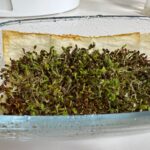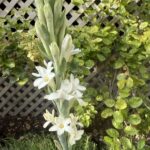This plant is new in my garden and I am still in the process of observing and looking at this. It is slow-growing and does a couple of interesting things. One, when exposed to the sun the outer leaves are tinged with red. The other thing is that when the sun is gone it spreads itself out like a long leaf and comes back together to resemble a mosaic when the sun is back. This is an evening shot at twilight. No flowers yet. But as usual, the internet offers a mine of information. I had written the above when I first got the plant. I am now updating it with further observations. I got the plant small and fearing the heat hid it away from the sun. That was a mistake and they all died. However, I begged my friend for one more and she gave me a slightly more mature plant. This has now sustained and spread well in the pot. They need a bright area with either morning sun or late evening sun to flourish even in summer. In winters in the Gulf, they need the full sun to produce flowers. I think the best time frame for the flowering would be in the March April time frame.

Most of the information and the photo below has been taken from the website https://pondinformer.com/mosaic-plant-ludwigia-sedioides/
Belonging to the evening primrose family, Onagraceae, and the water primrose genus, Ludwigia, mosaic plant, also called mosaic flower or false loosestrife, is one of the very few members of this genus that belongs south of the equator. The Mosaic plant is an outlier of both its family and genus – it is native to South America, primarily Venezuela, Panama, Columbia, and Brazil. As such, it thrives in warm, sunny, damp conditions. The leaves of the Mosaic plant whorl outward in a circular basal rosette that floats atop the water’s surface, with each diamond-shaped leaf resembling a tiny, intricate tile within a mosaic pattern. To further this likeness, when in full sun the leaves will go from being entirely green to having deeply red-tinted edges, as though painted. Some of the leaves toward the outside of the rosette may turn entirely red. The yellow, buttercup-like flowers that bloom throughout summer draw in beneficial pollinators like various bees and butterflies. Since mosaic plant floats atop the water’s surface and extends its roots to the bottom of the water body, it’s able to absorb excess nutrients and pollutants throughout the water column.
The floating rosettes also help to shade the water, reduce algae, and provide cover for any pond residents from predators.
It has not flowered in my garden yet mainly because I planted it in early summer. I will now expect blooms in late September. But just for your information here is a picture from the internet for you.







2 Responses
Beautiful 🤩
Thank you